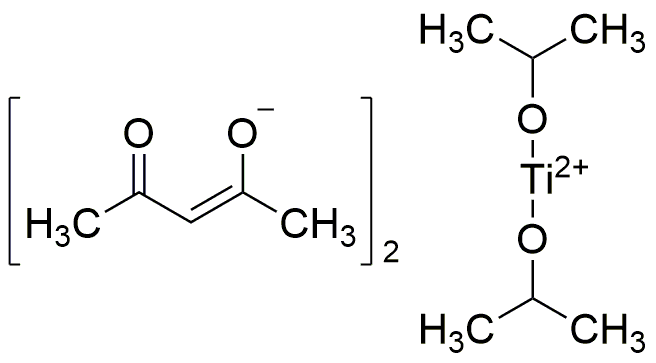Bis(2,4-pentanedionato)bis(2-propanolato)titanium(IV) is widely utilized in research focused on:
- Coatings and Paints: This compound serves as a precursor for titanium-based coatings, enhancing durability and resistance to corrosion in automotive and industrial applications.
- Catalysis: It is employed as a catalyst in various chemical reactions, including polymerization processes, improving reaction rates and product yields in the plastics industry.
- Biomedical Applications: The compound is explored for its potential in drug delivery systems and as a biocompatible material in medical implants, offering improved integration with biological tissues.
- Nanotechnology: It is used in the synthesis of titanium dioxide nanoparticles, which are valuable in photocatalysis and environmental remediation, providing effective solutions for pollution control.
- Electronics: This chemical plays a role in the production of thin-film transistors and other electronic components, contributing to advancements in flexible and high-performance electronic devices.
General Information
Properties
Safety and Regulations
Applications
Bis(2,4-pentanedionato)bis(2-propanolato)titanium(IV) is widely utilized in research focused on:
- Coatings and Paints: This compound serves as a precursor for titanium-based coatings, enhancing durability and resistance to corrosion in automotive and industrial applications.
- Catalysis: It is employed as a catalyst in various chemical reactions, including polymerization processes, improving reaction rates and product yields in the plastics industry.
- Biomedical Applications: The compound is explored for its potential in drug delivery systems and as a biocompatible material in medical implants, offering improved integration with biological tissues.
- Nanotechnology: It is used in the synthesis of titanium dioxide nanoparticles, which are valuable in photocatalysis and environmental remediation, providing effective solutions for pollution control.
- Electronics: This chemical plays a role in the production of thin-film transistors and other electronic components, contributing to advancements in flexible and high-performance electronic devices.
Documents
Safety Data Sheets (SDS)
The SDS provides comprehensive safety information on handling, storage, and disposal of the product.
Product Specification (PS)
The PS provides a comprehensive breakdown of the product’s properties, including chemical composition, physical state, purity, and storage requirements. It also details acceptable quality ranges and the product's intended applications.
Certificates of Analysis (COA)
Search for Certificates of Analysis (COA) by entering the products Lot Number. Lot and Batch Numbers can be found on a product’s label following the words ‘Lot’ or ‘Batch’.
*Catalog Number
*Lot Number
Certificates Of Origin (COO)
This COO confirms the country where the product was manufactured, and also details the materials and components used in it and whether it is derived from natural, synthetic, or other specific sources. This certificate may be required for customs, trade, and regulatory compliance.
*Catalog Number
*Lot Number
Safety Data Sheets (SDS)
The SDS provides comprehensive safety information on handling, storage, and disposal of the product.
DownloadProduct Specification (PS)
The PS provides a comprehensive breakdown of the product’s properties, including chemical composition, physical state, purity, and storage requirements. It also details acceptable quality ranges and the product's intended applications.
DownloadCertificates of Analysis (COA)
Search for Certificates of Analysis (COA) by entering the products Lot Number. Lot and Batch Numbers can be found on a product’s label following the words ‘Lot’ or ‘Batch’.
*Catalog Number
*Lot Number
Certificates Of Origin (COO)
This COO confirms the country where the product was manufactured, and also details the materials and components used in it and whether it is derived from natural, synthetic, or other specific sources. This certificate may be required for customs, trade, and regulatory compliance.


